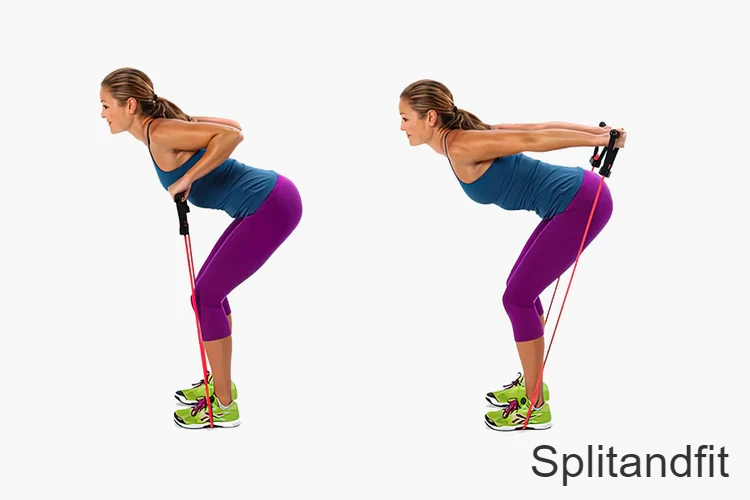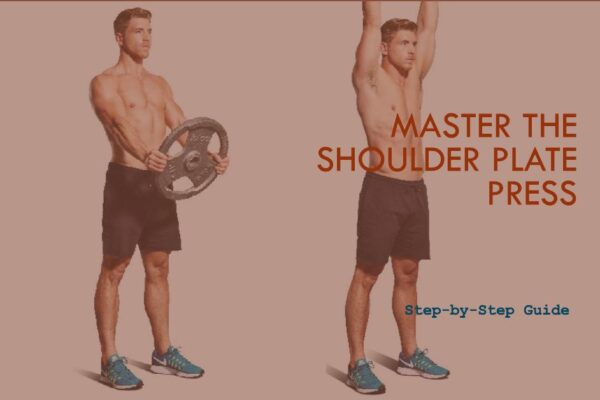Resistance band tricep workouts offer a versatile and effective way to strengthen and tone the triceps, one of the key muscle groups in the arms. By utilizing resistance bands in your tricep exercises, you can effectively target all three heads of the triceps—long head, medial head, and lateral head—resulting in comprehensive muscle development.
Whether you’re looking to build arm strength, improve muscle definition, or enhance your overall fitness level, incorporating resistance band tricep workouts into your exercise routine can be a valuable addition. These workouts are suitable for individuals of various fitness levels and can be easily customized to fit personal preferences and goals.
What are Resistance Band Tricep Workouts?
Resistance band tricep workouts involve utilizing resistance bands in various exercises to target and strengthen the triceps effectively. Some of the best exercises include standing overhead extensions, tricep pushdowns, and tricep kickbacks. These workouts provide a comprehensive approach to developing all three heads of the triceps and can be customized to suit different fitness levels and goals.

Muscles Worked By Resistance Band Tricep Workouts
Resistance band tricep workouts target the triceps brachii muscle group, which is composed of three heads: the lateral head, long head, and medial head. These exercises help engage and strengthen the triceps effectively, contributing to improved arm strength and muscle definition. Some of the key muscles worked during resistance band tricep workouts also include the anterior deltoids and pectorals.
Benefits of Training The Triceps With Resistance Bands
- Enhanced Muscle Strength Without Excessive Stress: Training the triceps with resistance bands builds strength and power efficiently, while also minimizing the risk of muscle overexertion, making it a safer alternative to traditional weightlifting.
- Versatile and Accessible Workouts: The adaptability of resistance bands allows for a wide range of tricep exercises that can be modified to suit any fitness level. This versatility ensures effective workouts whether at home, in the gym, or on the go.
- Improved Joint Health and Injury Prevention: Resistance band exercises are low-impact, reducing stress on joints compared to heavy weights, which makes them an excellent option for injury prevention and rehabilitation.
- Full Range of Motion and Flexibility: Utilizing resistance bands encourages a full extension of the arms during workouts, improving both muscle flexibility and strength. This contributes to better overall arm aesthetics and functionality.
- Increased Muscle Coordination and Stability: Working out with resistance bands requires greater muscle stabilization, enhancing body awareness and control. Improved coordination benefits performance in daily activities and sports, making resistance bands a valuable tool for comprehensive fitness training.

Best Resistance Band Tricep Workouts
Here are the top 8 Resistance Band Tricep Workouts:
- Standing Overhead Tricep Extension
- Tricep Kickbacks
- Tricep Pushdowns
- Close Grip Press
- Tricep Dips with Resistance Bands
- Tricep Pulldowns
- One-Arm Tricep Extension
- Diamond Push-Ups with Resistance Bands
1. Standing Overhead Tricep Extension
The Standing Overhead Tricep Extension with a Resistance Band is a versatile and effective exercise that targets the triceps, the muscles on the back of the upper arm. This exercise is beneficial for increasing arm strength, promoting muscle growth, and enhancing overall upper body conditioning. Using a resistance band for this movement adds a unique challenge compared to free weights, as the tension from the band increases at the point of full extension, providing constant resistance throughout the movement.
How to Perform:
- Band Positioning: Stand with your feet shoulder-width apart. Place one end of the resistance band under your rear foot and hold the other end with both hands. Adjust your stance if needed to ensure the band’s tension.
- Starting Position: Raise your arms above your head, fully extending them while holding the band tightly. Your palms should face each other, and your elbows should be close to your ears.
- Execution: Keeping your upper arms stationary, bend your elbows to lower the band behind your head slowly. The movement should occur only in your forearms.
- Extension: Push through your triceps to extend your arms back to the starting position. Focus on the triceps contraction as you return to full extension.
- Repetition: Repeat the movement for the desired number of repetitions, maintaining a controlled pace and steady tension on the band.
Tips:
- Elbow Position: Ensure your elbows remain pointed forward and do not flare out to the sides to maximize triceps engagement and effectiveness.
- Stable Core: Keep your core engaged throughout the exercise to support your spine and provide stability.
- Controlled Movement: Move through the exercise with controlled motions, avoiding any jerky movements or using momentum to lift the band.
- Adjust Tension: If the exercise feels too easy or too difficult, adjust your standing position or switch to a different resistance band to either decrease or increase the tension.
- Breathing: Inhale as you lower the band behind your head and exhale as you extend your arms, focusing on breathing deeply and steadily throughout your sets.
Incorporating the Standing Overhead Tricep Extension with a Resistance Band into your workout routine can significantly improve tricep strength and endurance, contributing to better performance in various upper body exercises and daily activities.
2. Tricep Kickbacks
Tricep kickbacks with a resistance band are an effective exercise for targeting the triceps muscles at the back of the upper arm. This variation of the traditional tricep kickback uses the unique resistance provided by a band to enhance muscle engagement and growth. The exercise is beneficial for increasing arm strength, improving muscle tone, and supporting upper body functional movements.
How to Perform:
- Band Setup: Stand on the middle of the resistance band with your feet shoulder-width apart. Bend slightly forward at the waist while keeping your back straight. Hold the ends of the band with each hand.
- Starting Position: With a firm grip on the band, bend your elbows so that your upper arms are aligned with your torso, parallel to the floor. Your forearms should be perpendicular to the floor, and your palms facing inwards towards each other.
- Execution: Keeping your upper arms stationary, extend your forearms back and upwards until your arms are fully extended behind you. Focus on moving only your forearms and maintaining a steady posture.
- Contraction: Pause briefly at the top of the movement to squeeze the triceps, ensuring you’re maximizing muscle engagement.
- Return Phase: Slowly return your forearms to the starting position, maintaining control of the band’s tension throughout the movement.
- Repetition: Repeat for the desired number of repetitions before switching arms if performing the exercise one arm at a time.
Tips:
- Stable Core: Engage your core throughout the exercise to maintain balance and provide support for your upper body.
- Elbow Placement: Ensure your elbows remain close to your sides and do not move during the exercise. The movement should solely involve the extension and retraction of your forearms.
- Controlled Motion: Perform each repetition with controlled, deliberate movements to prevent using momentum, which can reduce the effectiveness of the exercise.
- Adjust Resistance: If the exercise feels too easy or too difficult, adjust your foot positioning on the band or switch to a different resistance level to increase or decrease the difficulty.
- Breathing: Maintain a consistent breathing pattern by exhaling as you extend your arms and inhaling as you return to the starting position.
Incorporating tricep kickbacks with a resistance band into your workout routine can significantly enhance tricep strength and definition. This exercise offers a practical and efficient way to target the triceps using the adaptable resistance of a band, making it suitable for fitness enthusiasts of all levels.
3. Tricep Pushdowns
Tricep pushdowns with a resistance band are an effective exercise for targeting and strengthening the triceps muscles located at the back of the upper arms. This variant of the traditional cable tricep pushdown allows for a more accessible and versatile approach, as it can be performed almost anywhere with a resistance band. The exercise involves pushing down against the resistance of the band to isolate and work the triceps.
How to Perform:
- Band Setup: Secure the resistance band around a stable, elevated anchor point above your head, such as a pull-up bar or a sturdy hook. Ensure the band is firmly in place to prevent slipping.
- Grip: Stand facing the anchor point, grab the band with both hands, palms facing down. Your hands should be about shoulder-width apart or slightly narrower to increase triceps engagement.
- Starting Position: Begin with your elbows bent and your forearms parallel to the floor. Keep your elbows close to your sides to isolate the triceps effectively.
- Push Down: Extend your arms downwards by straightening your elbows, pushing against the resistance of the band. Your upper arms should remain stationary, with only your forearms moving.
- Peak Contraction: Once your arms are fully extended at the bottom, hold the position briefly to maximize the contraction in your triceps.
- Return: Slowly allow your arms to return to the starting position, controlling the resistance of the band to maintain tension in the triceps throughout the movement.
Tips:
- Posture: Maintain a straight back and slightly bent knees throughout the exercise to ensure stability and prevent any unnecessary strain on your lower back.
- Elbow Positioning: Keep your elbows tucked in at your sides during the entire exercise to focus the effort on your triceps and avoid engaging the shoulders excessively.
- Controlled Movements: Execute each phase of the exercise—both the pushdown and the return—with controlled movements to maximize triceps engagement and prevent using momentum.
- Resistance Adjustment: To increase or decrease the difficulty, adjust your standing position relative to the anchor point or use a band with a different level of resistance.
- Breathing: Breathe out as you push down and contract your triceps, and inhale as you return to the starting position. Proper breathing helps maintain rhythm and supports exertion during the exercise.
Incorporating tricep pushdowns with a resistance band into your workout routine is an excellent way to build tricep strength and definition without the need for heavy weights or access to a gym. This exercise provides a convenient and effective way to target the triceps, promoting muscle growth and endurance.
4. Close Grip Press
The Close Grip Press with a resistance band is an innovative adaptation of the traditional close grip bench press, focusing on strengthening the triceps, chest (pectoralis major), and front of the shoulders (anterior deltoids). This exercise variation utilizes the unique resistance provided by bands to challenge the muscles differently than free weights, promoting muscle engagement and growth through a full range of motion with constant tension.
How to Perform:
- Setup: Lay the resistance band flat on the floor. Lie down on your back over the band, ensuring it runs across the middle of your back just below the shoulder blades. Grab each end of the band with your hands.
- Grip and Position: Hold the ends of the band so that your palms face each other, similar to holding a barbell. Your hands should be closer than shoulder-width apart to emphasize tricep engagement. Press your feet firmly into the ground, bend your knees, and set your starting position with your arms extended above your chest.
- Lowering Phase: Slowly lower your hands towards your chest by bending your elbows. Keep the movement controlled and ensure your elbows stay close to your sides to maximize triceps activation.
- Pressing Phase: Push your hands back up to the starting position by extending your elbows and contracting your triceps and chest. Focus on the pushing motion primarily engaging through your triceps.
- Repetition: Perform the desired number of repetitions, maintaining a fluid and controlled motion throughout.
Tips:
- Stable Core: Engage your core throughout the exercise to maintain stability and support for your lower back.
- Elbow Positioning: Keep your elbows tucked in close to your body to ensure the focus remains on the triceps and to prevent unnecessary shoulder strain.
- Adjust Resistance: To increase or decrease the difficulty, adjust the tightness of the band before starting the exercise. A tighter band increases resistance, while a looser band decreases it.
- Breathing: Inhale as you lower your hands towards your chest and exhale forcefully as you press back up to the starting position. Proper breathing supports effort and stability.
- Progression: As you become more comfortable with the exercise, experiment with different band thicknesses to continually challenge your muscles.
The Close Grip Press with a resistance band is an excellent exercise for those looking to build upper body strength without access to traditional gym equipment. It offers a portable, versatile, and effective way to target key muscle groups with the added benefits of resistance band training, such as improved muscle activation and joint safety.
5. Tricep Dips with Resistance Bands
Tricep dips with resistance bands are an innovative way to perform the classic tricep dip exercise, providing additional support and allowing individuals at different fitness levels to engage in this effective upper body workout. By incorporating resistance bands, users can adjust the difficulty of the exercise, making it more accessible for beginners or providing extra resistance for more advanced users. This variation targets the triceps, chest, and shoulders, promoting muscle strength and endurance.
How to Perform:
- Setup: Secure a resistance band around a stable bar above you. If performing band-assisted dips, loop the band around the dip bars and place your knees or feet in the band for support.
- Positioning: Grip the dip bars with your hands shoulder-width apart, arms straight but not locked out. Lean slightly forward to engage your chest and triceps.
- Descending: Slowly lower your body by bending your elbows until they form a 90-degree angle. Ensure your elbows point backward and stay close to your body.
- Ascending: Push through your palms to extend your elbows and lift your body back to the starting position.
- Repetition: Perform the desired number of repetitions, maintaining a controlled movement throughout the exercise.
Tips:
- Form First: Prioritize maintaining proper form over the number of reps or the resistance level of the band. This helps prevent injury and ensures maximum muscle engagement.
- Adjust Band Tension: Use a resistance band that matches your fitness level. Thicker bands offer more assistance, while thinner bands provide less.
- Engage Your Core: Keep your core engaged throughout the exercise to stabilize your body and enhance the effectiveness of the workout.
- Focus on Triceps: Although the chest and shoulders are involved, concentrate on using your triceps to push yourself up to maximize triceps development.
- Progress Gradually: As you become stronger, gradually decrease the assistance by using a lighter band or increasing the number of repetitions to challenge your muscles further.
Tricep dips with resistance bands are a versatile and effective exercise for building upper body strength, particularly in the triceps. Whether you’re looking to progress in your tricep dips or add variety to your workout routine, incorporating resistance bands can provide both support and added resistance to help you achieve your fitness goals.
6. Tricep Pulldowns
Tricep pulldowns, also commonly referred to as tricep pushdowns when using resistance bands, are a versatile upper-body exercise that primarily targets the triceps muscles. This exercise is excellent for building strength and definition in the arms, utilizing the constant tension provided by a resistance band. It’s a popular choice for those who seek an effective triceps workout without the need for heavy gym equipment.
How to Perform:
- Setup: Anchor the resistance band at a high point above your head. This could be a door anchor placed at the top of a door or any secure, elevated anchor point.
- Grip: Stand facing the anchor point and grasp each end of the resistance band with your hands. Your palms should face down (overhand grip).
- Starting Position: Begin with your elbows bent and hands positioned at chest level. Keep your elbows close to your sides to target the triceps effectively.
- Execution: Extend your arms downward by straightening your elbows, pushing down against the resistance of the band. Your upper arms should remain stationary, with movement occurring only at the forearms.
- Contraction: Once your arms are fully extended at the bottom, pause briefly to squeeze your triceps, maximizing muscle engagement.
- Return: Slowly release the tension and allow your arms to return to the starting position, controlling the resistance of the band throughout the movement.
Tips:
- Maintain Posture: Keep your back straight and core engaged throughout the exercise. A slight forward lean is acceptable but avoid excessive leaning or arching of the back.
- Elbow Placement: Ensure your elbows remain pinned at your sides during the entire exercise to isolate the triceps effectively.
- Controlled Movements: Focus on slow, controlled movements to maximize the effectiveness of the exercise and minimize the risk of injury.
- Adjust Resistance: Step closer to or further away from the anchor point to adjust the resistance of the band. This allows you to customize the difficulty of the exercise to match your fitness level.
- Variety: Experiment with different grips and attachments (e.g., using a rope attachment or changing grip width) to target the triceps from various angles and promote balanced muscle development.
Tricep pulldowns with a resistance band offer a practical and efficient way to target the triceps, making them a valuable addition to any resistance band workout routine. By emphasizing proper form and technique, individuals can achieve significant gains in triceps strength and appearance.
7. One-Arm Tricep Extension
The One-Arm Tricep Extension with a resistance band is a focused and effective exercise for isolating and strengthening the triceps muscle. This exercise specifically targets the long head of the triceps, which is crucial for overall arm aesthetics and strength. By using a resistance band, this exercise offers adaptable resistance levels and can be performed virtually anywhere, making it an excellent choice for both gym and home workouts.
How to Perform:
- Band Setup: Place the resistance band under your foot (if standing) or secure it at a low anchor point. Ensure the band has enough tension when your arm is extended overhead.
- Starting Position: Grasp the end of the band with the hand of the working arm. Extend your arm overhead, keeping your elbow close to your head. The non-working hand can be placed on your waist for stability.
- Execution: Slowly lower your forearm behind your head by bending at the elbow. Keep your upper arm stationary, and your elbow pointed upwards throughout the movement.
- Extension: Extend your arm back to the starting position, focusing on contracting the triceps muscle to lift the resistance.
- Repetition: Complete the desired number of repetitions before switching arms to ensure balanced development.
Tips:
- Elbow Positioning: To effectively target the triceps, keep your elbow as close to your head as possible during the exercise. Avoid letting your elbow flare out to the sides.
- Controlled Movements: Perform each extension with controlled motion to maximize triceps engagement and prevent reliance on momentum.
- Stable Core: Engage your core throughout the exercise to maintain proper posture and balance, especially important when standing.
- Adjust Resistance: You can adjust the difficulty of the exercise by changing your grip on the band to increase or decrease tension or by using bands of different thicknesses.
- Breath Control: Inhale as you lower your forearm and exhale as you extend your arm. Proper breathing technique aids in muscle activation and stability.
The One-Arm Tricep Extension with a resistance band is a versatile and effective exercise for enhancing tricep strength and definition. Its simplicity and adaptability make it suitable for all fitness levels, providing a convenient way to target the triceps without the need for heavy weights or complex equipment.
8. Diamond Push-Ups with Resistance Bands
Diamond push-ups with resistance bands are an advanced variation of the traditional push-up. This exercise combines the tricep-targeting benefits of diamond push-ups with the added resistance of a band to intensify the workout, engaging not only the triceps but also the chest and anterior deltoids more effectively.
How to Perform:
- Setup: Place a resistance band behind your back, holding each end with your hands. Position your hands on the floor directly under your chest, touching your thumbs and index fingers together to form a diamond shape.
- Starting Position: Extend your legs behind you, balancing on the balls of your feet, to assume a high plank position. Ensure the resistance band is taut across your upper back.
- Lowering Phase: Keeping your body in a straight line and engaging your core, slowly lower yourself towards the floor by bending your elbows. Go as low as you can while maintaining form.
- Push-Up: Press through your hands, extending your elbows to push yourself back up to the starting position against the resistance of the band.
- Repetition: Perform the desired number of repetitions, maintaining a steady pace and controlled movements.
Tips:
- Hand Position: The diamond shape made by your hands increases the focus on your triceps. Ensure your hands remain directly below your chest throughout the exercise to maintain proper form.
- Elbow Path: As you lower down, aim to keep your elbows close to your body rather than flaring them out wide, to maximize triceps engagement.
- Core Engagement: Actively engage your core throughout the exercise to keep your body in a straight line and avoid sagging or piking at the hips.
- Breathing: Inhale on the way down and exhale on the push-up phase. Proper breathing helps maintain stability and power through the movement.
- Progression: To increase the challenge, you can use a thicker resistance band for more tension or increase the number of repetitions and sets.
Diamond push-ups with resistance bands are an effective way to enhance upper body strength, especially in the triceps and chest. By focusing on form and incorporating these tips, you can safely add this challenging variation to your workout routine for improved muscle definition and strength.
Frequent Question Answers
| Question | Answer |
|---|---|
| Can you build triceps with resistance bands? | Yes, resistance bands are effective for building triceps as they allow focusing on each of the 3 heads of the triceps muscle. |
| Can resistance bands tone arms? | Yes, resistance bands are very effective for training and toning your triceps, contributing to overall arm toning. |
| Can you get bigger arms with resistance bands? | Yes, resistance bands can be used effectively for muscle growth in the arms due to the constant tension they provide during exercises. |
| How to do tricep press with resistance bands? | To perform a tricep press with resistance bands, stand on the band with feet shoulder-width apart, hold the ends of the band with both hands, and extend your arms fully above your head, keeping elbows close to your ears. |
| How to get big triceps? | To achieve big triceps, incorporate exercises targeting all three heads of the triceps, maintain a protein-rich diet for muscle repair and growth, and ensure proper rest and recovery. |
| Do triceps need high reps? | High reps can be beneficial for triceps development, especially when aiming for muscle endurance and toning, but a mix of high and low reps is optimal for overall growth. |
| Do triceps grow slow? | Triceps growth rate can vary by individual based on genetics, training intensity, and nutrition, but consistent training can lead to visible growth over time. |
| Are triceps hard to grow? | Triceps can be challenging to grow if not targeted effectively, but with the right exercises, intensity, and recovery, significant growth is achievable. |
| Is tricep size genetic? | Yes, the natural size and shape of your triceps, like all muscles, are influenced by genetics, but dedicated training can significantly impact their development. |
Conclusion
Resistance band tricep workouts stand out as a highly efficient and versatile method for enhancing tricep strength, size, and definition. The unique constant tension provided by resistance bands throughout the range of motion ensures a thorough engagement of all three heads of the triceps muscle, leading to effective muscle growth and development.
These workouts offer the added benefits of adaptability to different fitness levels, portability for exercise on the go, and a safe alternative to traditional weights, making them an excellent choice for anyone looking to improve their upper arm aesthetics and functionality.
Through consistent practice and proper technique, incorporating resistance band exercises into a tricep regimen can yield significant improvements, demonstrating the power of simplicity and flexibility in achieving fitness goals.






Leave a Reply